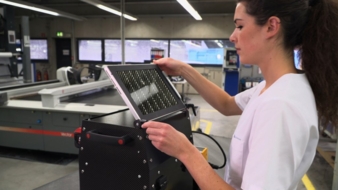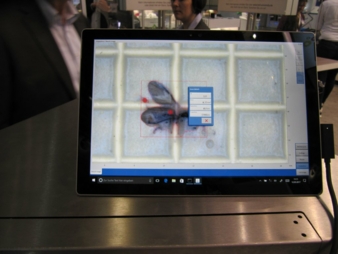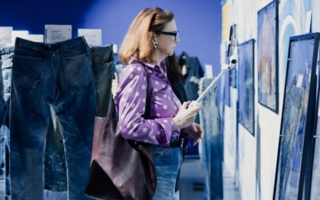27/06/2017 – Robomat — auf Deutsch lesen
Techtextil: Digital surface microscope
A world premiere at the fair Techtextil 2017: A hybrid camera - microscope and photographic camera in one. Inspired by the eyesight of the eagle.
Product Development and Quality Inspection: The search for a material defect in textile materials is more efficient: image triggered - the integrated image recognition marks errors. A marked location can be enlarged and controlled with two fingers on the touch screen. Scale back to a DIN A4 sized overview and manually zoom in on the next error or leave the search for errors in their entirety to the image recognition software.
Everyone has experienced the paradox for themselves: If you have to look for small details (such as material defects) in a large area with a magnifying glass or microscope, you quickly lose track of time and incur a loss of accuracy. Dieter Ainedter from Salzburg has solved the problem together with his team and what was previously an either or situation on time or accuracy is now finite and encompassing solution named Roboskop.
A clever development from standard components
The solution is based on the combination of the fastest and most powerful tablet using Windows and high grade digital cameras with the highest resolution. Image recognition software, a light box and the motorized control of lens and axles.
"Our role model was the eagle", explains Dipl. Ing. Ainedter, director of Robomat Germany, an engineering think-tank in Freilassing. "It manages to maintain an enormous area in its field of vision at a height of more than a kilometre and at the same time focus on a small mouse down on the ground." An extreme wide angle lens and mega telescope in one so to speak. "This has not yet been possible in technical product development and quality control," says Ainedter. "Only a small part of the material sample can be analysed under the microscope in the laboratory. As a result, the meticulous testing of an area with the dimensions of an A4 sheet becomes an endlessly time-consuming process. "Even worse: Hundreds of such analyses have to be carried out in the new development of materials. This is a hindrance to product development that costs a great deal of time and money."
Mobile eagle eye as an innovation accelerator
It’s different with the Roboskop: The eagle eye captures an area the size of a complete A4 page "at a glance" instead of focusing on a tiny area under the ocular as with conventional technologies. This multiplies the speed of error detection. The Roboskop sees like the bird of prey when compared to a conventional microscope and identifies the errors on the surface and emulates the detailed resolution: multiple cameras with the highest available megapixel density combined with integrated image recognition allows for the detection of miniscule material errors of only 1/100 millimeter (10 μ) in size. This is five times smaller than the thickness of a human hair. The image recognition software of the surface microscope provides real-time information pertaining to the type and extent of the problem: Frequency, area, diameter, statistical distribution and other deficiency categories are automatically detected, marked and logged.
A significant increase of quality control in many industries
"This means a huge increase in efficiency in product development, analysis and quality control," says Ainedter, "not only in the textile industry and in technical textiles such as carbon fibres. There is also interest in the determination of differing species of micro-organisms and environmental analysis.”
The Roboskop is available in two versions: A portable Roboskop mobile version that can be operated directly on an inspection table and in a laboratory version employing motor controlled axles movement to position the camera above the specimen.





